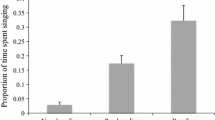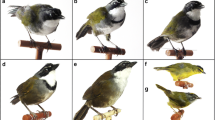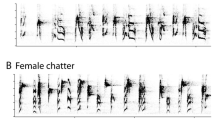Abstract
Imitative song learning in birds often results in the formation of vocal dialects or local song neighborhoods in which males in close proximity share very similar songs. If song sharing confers a selective advantage due to intra-sexual competition or inter-sexual mate choice, song sharing should enhance the singer’s territory tenure or lifetime pairing success. We tested this in a migratory population of the Puget Sound white-crowned sparrow, Zonotrichia leucophrys pugetensis, in which some territory neighbors share whole songs. Song sharing with territory neighbors in the first year on territory did not correlate with territory tenure but correlated positively with social pairing success throughout a male’s lifetime when length of territory tenure was controlled. Thus, song sharing in this migratory population does not appear to confer a benefit in male–male interactions, at least as measured by the length of territory tenure. However, males that share songs do benefit from higher lifetime pairing success. Combined with the data available for other species, it appears that intra- and inter-sexual selection may have stronger effects on song sharing in sedentary and migratory populations, respectively.



Similar content being viewed by others
References
Armstrong E (1973) A study of bird song, 2nd edn. Dover, New York
Baptista LF (1975) Song dialects and demes in sedentary populations of the white-crowned sparrow (Zonotrichia leucophrys nuttalli). Univ Calif Publ Zool 105:1–52
Baptista LF (1977) Geographic variation in song and dialects of the Puget Sound white-crowned sparrow. Condor 79:356–370
Beecher M (2008) Function and mechanisms of song learning in song sparrows. Adv Stud Behav 38:167–225
Beecher MD, Brenowitz EA (2005) Functional aspects of song learning in songbirds. Trends Ecol Evol 20:143–149
Beecher MD, Campbell SE, Nordby JC (2000) Territory tenure in song sparrows is related to song sharing with neighbours, but not to repertoire size. Anim Behav 59:29–37
Benjamini Y, Hochberg Y (1995) Controlling the false discovery rate: a practical and powerful approach to multiple testing. J Roy Stat Soc C-App 57:289–300
Breitwisch R (1989) Mortality patterns, sex ratios, and parental investment in monogamous birds. In: Power DM (ed) Current ornithology. Plenum, New York, pp 1–50
Catchpole CK (1982) The evolution of bird sounds in relation to mating and spacing behavior. In: Kroodsma DE, Miller EH (eds) Acoustic communication in birds: I. Production, perception, and design features of sounds. Academic, New York, pp 297–319
Catchpole CK, Slater P (2008) Bird song, 2nd edn. Cambridge University Press, Cambridge
Cosens SE, Sealy SG (1986) Age-related variation in song repertoire size and repertoire sharing of yellow warblers (Dendroica petechia). Can J Zool 64:1926–1929
DeWolfe BB, Baptista LF (1995) Singing behavior, song types on their wintering grounds and the question of leap-frog migration in Puget Sound white-crowned sparrows. Condor 97:376–389
Elekonich MM (1998) Song sparrow males use female-typical vocalizations in Fall. Condor 100:145–148
Handley H, Nelson DA (2005) Ecological and phylogenetic influences on vocal dialect formation in song birds. Ethology 111:221–238
Hill CE, Akcay C, Campbell SE, Beecher MD (2010) Extrapair paternity, song, and genetic quality in song sparrows. Behav Ecol 22:73–81
Hughes M, Hyman J (2011) Should I stay or should I go now: late establishment and low site fidelity as alternative territorial behaviors. Ethology 117:1–13
Hughes M, Anderson RC, Searcy WA, Bottensek LM, Nowicki S (2007) Song type sharing and territory tenure in eastern song sparrows: implications for the evolution of song repertoires. Anim Behav 73:701–710
Kokko H (1999) Competition for early arrival in migratory birds. J Anim Ecol 68:940–950
Krebs JR, Kroodsma DE (1980) Repertoires and geographical variation in bird song. Adv Stud Behav 11:143–177
Kroodsma DE, Baylis JR (1982) Appendix: a world survey of evidence for vocal learning in birds. In: Kroodsma DE, Miller EH (eds) Acoustic communication in birds: II. Song learning and its consequences. Academic, New York, pp 311–337
Lapierre J, Mennill D, MacDougall-Shackleton E (2011) Spatial and age-related variation in use of locally common song elements in dawn singing of song sparrows, Melospiza melodia: old males sing the hits. Behav Ecol Sociobiol 65:2149–2160
Marler P, Peters S (1982) Subsong and plastic song: their role in the vocal learning process. In: Kroodsma DE, Miller EH (eds) Acoustic communication in birds: II. Song learning and its consequences. Academic, New York, pp 25–50
Marler P, Tamura M (1962) Song “dialects” in three populations of white-crowned sparrows. Condor 64:368–377
McGregor PK, Krebs JR (1984) Song learning and deceptive mimicry. Anim Behav 32:280–287
Morton ML (2002) The mountain white-crowned sparrow: migration and reproduction at high altitude. Stud Avian Biol 24:1–236
Mundinger PC (1982) Microgeographic and macrogeographic variation in acquired vocalizations of birds. In: Kroodsma DE, Miller EH (eds) Acoustic communication in birds: II. Song learning and its consequences. Academic, New York, pp 147–208
Nelson DA (2000) Song overproduction, selective attrition, and vocal dialects in the white-crowned sparrow. Anim Behav 60:887–898
Nelson DA, Poesel A (2007) Segregation of information in a complex acoustic signal: individual and dialect identity in white-crowned sparrow song. Anim Behav 74:1073–1084
Nelson DA, Poesel A (2009) Does learning produce song conformity or novelty in white-crowned sparrows? Anim Behav 78:433–440
Nelson DA, Poesel A (2011) Song length variation serves multiple functions in the white-crowned sparrow. Behav Ecol Sociobiol 65:1103–1111
Nelson DA, Whaling C, Marler P (1996) The capacity for song memorization varies in populations of the same species. Anim Behav 52:379–387
Nelson DA, Hallberg KI, Soha JA (2004) Cultural evolution of Puget Sound white-crowned sparrow song dialects. Ethology 110:879–908
Nowicki S, Peters S, Podos J (1998) Song learning, early nutrition and sexual selection in songbirds. Am Zool 38:179–190
Payne RB, Payne LL, Doehlert SM (1988) Biological and cultural success of song memes in indigo buntings. Ecology 69:104–117
Poesel A, Gibbs HL, Nelson DA (2011) Extrapair fertilizations and the potential for sexual selection in a socially monogamous songbird. Auk 128:770–776
Poesel A, Nelson DA, Gibbs HL (2012) Song sharing correlates with social but not extrapair mating success in the white-crowned sparrow. Behav Ecol 23:627–634
Read AF, Weary DM (1992) The evolution of bird song: comparative analyses. Philos T Roy Soc B 338:165–187
Rothstein SI, Fleischer RC (1987) Vocal dialects and their possible relation to honest status signalling in the brown-headed cowbird. Condor 89:1–23
Searcy WA, Nowicki S (2005) The evolution of animal communication: reliability and deception in signaling systems. Princeton University Press, Princeton
Sergio F, Newton I (2003) Occupancy as a measure of territory quality. J Anim Ecol 72:857–865
Vehrencamp SL (2000) Handicap, index, and conventional signal elements of bird song. In: Espmark Y, Amundsen T, Rosenqvist G (eds) Animal signals: signalling and signal design in animal communication. Tapir Academic, Trondheim, pp 277–300
Wilson PL, Towner MC, Vehrencamp SL (2000) Survival and song-type sharing in a sedentary subspecies of the song sparrow. Condor 102:355–363
Wingfield JC, Hahn TP (1994) Testosterone and territorial behaviour in sedentary and migratory sparrows. Anim Behav 47:77–89
Acknowledgments
We thank the Oregon State Parks Department, the staff at Bullard’s Beach State Park, and the Port of Bandon for granting permission to work on their properties. Mike Webster, Henrik Brumm, and two reviewers made helpful comments on the manuscript. We thank the NSF for financial support (IBN04-15842).
Ethical standards
These observations were made in accordance with State of Oregon and United States laws. Procedures were approved by the Ohio State University IACUC Protocol 2000A005.
Author information
Authors and Affiliations
Corresponding author
Additional information
Communicated by H. Brumm
Rights and permissions
About this article
Cite this article
Nelson, D.A., Poesel, A. Song sharing correlates with lifetime social pairing success but not territory tenure in the Puget Sound white-crowned sparrow. Behav Ecol Sociobiol 67, 993–1000 (2013). https://doi.org/10.1007/s00265-013-1525-6
Received:
Revised:
Accepted:
Published:
Issue Date:
DOI: https://doi.org/10.1007/s00265-013-1525-6




